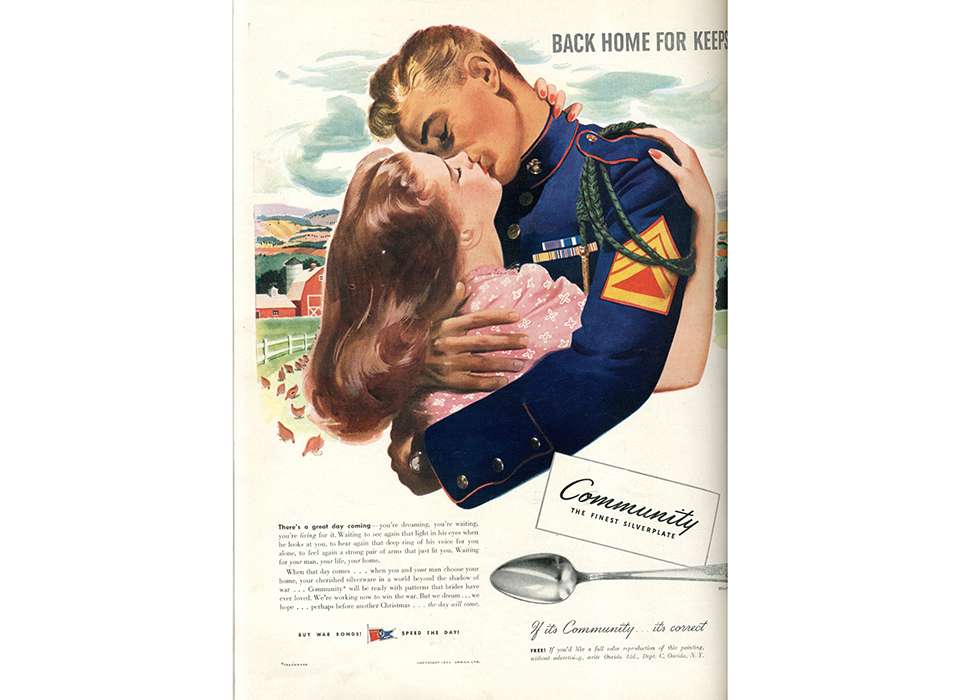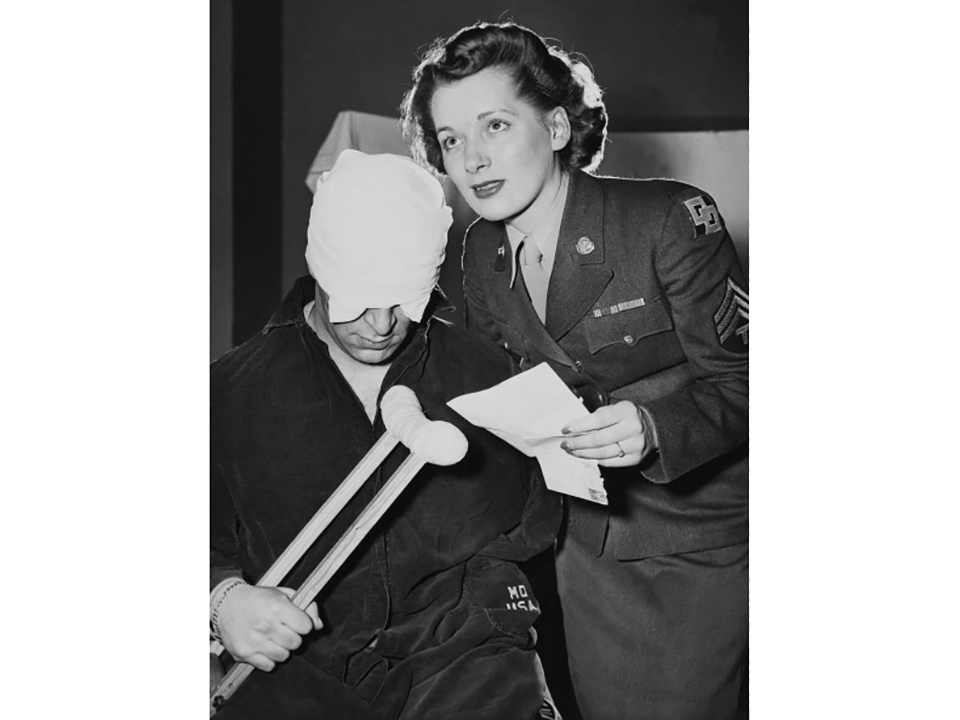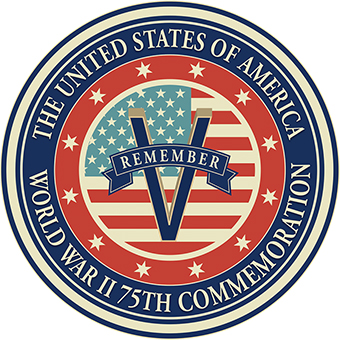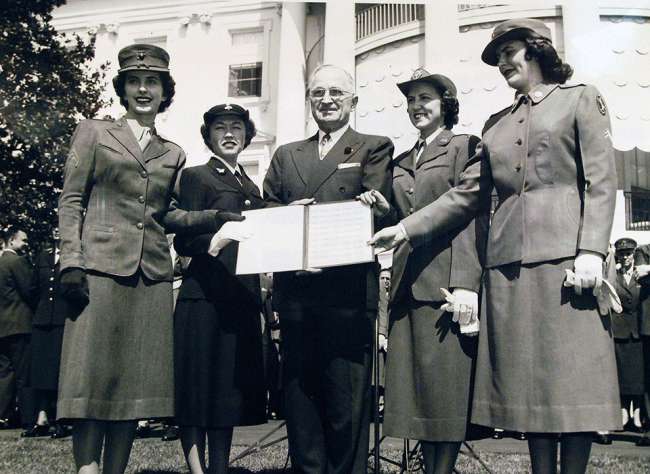Top Image: Oneida, Ltd. advertisement; “Back Home For Keeps.” World War II Advertisements - 1943. Western Connecticut State University Archives.
In the early 1940s, American society expected its men to adhere to specific characteristics that defined masculinity. In addition to courage and bravery, men strove to develop traits such as aggression, competition, stoicism, toughness, and independence in order to prove to others that they were truly masculine. Historian E. Anthony Rotundo teaches that Americans even believed that physical and “fighting virtues” played significant roles in a man’s identity because they built character. It is no wonder then that after the Great Depression—the greatest threat to one’s sense of manhood at the time because it threatened men’s positions as providers—World War II provided American soldiers with the opportunity to develop and prove their manhood to themselves and others. To be sure, the war provided opportunities for soldiers to foster their sense of manhood, but it also challenged these notions, particularly for men who were injured or faced lasting psychological trauma.
Moreover, at war’s end, changing social emphasis from war to peace prompted new ideas of manhood better suited for peacetime. Indeed, the war catalyzed a change that shifted the focus from the “tough” characteristics of masculinity to the need for veterans to create an idyllic postwar life with a family and a stable job. In short, the time had now come for these men to become good American citizens and contribute to the nation’s postwar advancement. However, the war’s physical and psychological legacies often made it difficult for men to reintegrate into civilian life and fulfill these duties.
The war challenged prevailing ideas of manhood in part because war required women’s participation, both civilian and military. As military service pulled men from industrial work, women began performing those roles to contribute to the war effort. As historian Elaine Tyler May writes, “the war emergency required the society to restructure itself and opened the way for the emancipation of women on an unprecedented scale.” American society promoted women’s expanded roles as a form of patriotism, but as soon as the war ended, many Americans expected women to return to the home to fulfill their domestic duties to prepare themselves for the time when they became wives and mothers. Employers now pushed women from higher-paying and secure wartime jobs to the service sector to make way for returning veterans. Thus, entering the workforce and becoming fathers and husbands now became the hallmarks of American masculinity after the war.
As scholar Michael Kimmel argues, returning veterans who just experienced the horrors of war expected a home with a family to provide them with a sense of security in a world that was increasingly becoming more insecure with the advent of the Cold War. Because they now embraced the move to domestic life after the harrowing war, veterans were okay with these changes. Many felt they had demonstrated how “manly” they were by serving in the military and used the benefits of that service to transition to civilian life.
In the years after World War II, and with the help of the Servicemen’s Readjustment Act, which provided ample educational and occupational opportunities, veterans now “sought to anchor their identities as successes as men” not by their military service but by being capable fathers and earning a living to support their families. However, these chances were limited for racial minorities and lower social classes. For example, Ira Katznelson teaches that Jim Crow laws limited African American veterans’ ability to use the GI Bill at all public institutions in the South; African Americans could only attend all-black colleges. Thus, future employment prospects were bleak for African Americans.
In addition to these limited opportunities for racial minorities, a significant number of veterans found that a smooth return home from the war and quick reintegration into society was not always possible. Many of them experienced physical wounds that made it difficult to be independent breadwinners for their families. During this period, the country relied on “whole” bodies to convey messages of national strength. Scholar Christina Jarvis asserts that the government used the male body and its sense of masculinity to demonstrate to the world that the United States was now a superpower. US citizens also subscribed to this ideal. The problem, however, was that 678,000 American soldiers suffered combat injuries that caused physical disabilities, and any returning men whose bodies were not “whole” challenged this message. More importantly, any physically disabled man could not always live up to the new standards of manhood.
Physical wounds from the war, then, created a sense of insecurity among veterans. These disabilities prevented many from entering the workforce and providing for their families. Popular literature during this time emphasized that women were to love and care for the physically wounded, but depending on women added to men’s feelings of inferiority. Jarvis further contends that the pamphlets’ and movies’ “focus on women’s agency . . . often leads to an erasure of men’s own self-healing powers and to readings that obscure the consolidation of male power in postwar America.” Americans perceived that a woman’s love could rehabilitate and restore a man’s sense of masculinity. But the “catch-22” of this assertion is that men had to rely on women to rejuvenate their identity. These men could not prove their masculinity by fixing themselves, nor could they always provide for their family; instead, they now depended on their families, especially their wives, for care.
World War II not only caused physical problems, its consequences affected men emotionally. These psychological scars also impeded veterans’ ability to contribute to society and become breadwinners. Men did not anticipate that the war would continue to have ripple effects on their mental health for years afterward. Roy Grinker and John Spiegel, two psychiatrists in the US Army Air Forces who dealt with thousands of psychiatric casualties, declared that psychological wounds created “inferiority feelings or socially unadapted behavior.” Moreover, an emotionally broken man had “shattered confidence and continued helplessness.” Thus, there was a prevalent fear among civilians and government officials that, due to psychological illness, veterans could not fulfill their new roles as citizens, husbands, and fathers.
In fact, Americans worried so much about veterans’ mental health and the need to treat these wounds that Congress passed the monumental National Mental Health Act of 1946 to create the National Institute of Mental Health, which earmarked significant funds for mental illness research. Testifying before the House of Representatives during the congressional hearings for this act, Colonel Samuel Challman, the deputy director of the neuropsychiatry division in the Surgeon General’s office, declared that this act was necessary for veteran rehabilitation and reintegration to society. He declared that during the war, “mental illness was the greatest cause of noneffectiveness or loss of manpower.” He seemingly worried that if the government or military did not find a way to treat mental illness, that “noneffectiveness” would carry over into civilian life after the war. Indeed, he testified, “we are concerned about the fate of the men we have been dealing with during these past 4 years in service. We know there are a large number of them in the Army now, and many of them are going to need help when they get back into civilian life.”
One Congressman, Walter Judd (R-Minnesota), mirrored Colonel Challman’s sentiments. Moreover, Judd’s testimony is more detailed and thorough concerning the American man’s new responsibilities. He remarked that the act was necessary to ensure that veterans specifically became productive citizens and family men. To accomplish this task, Judd declared that society first needed to stop unnecessarily stigmatizing psychological casualties. He continued:
“Part of our purpose in this bill is to correct that attitude which is based on ignorance. The most terribly tragic figures coming back from this war are not the boys with their legs off or their eyes out, or their backs broken. Rather they are the men with their spirits broken. If they can have the right kind of psychiatric study and assistance and guidance and training during these first critical months of readjustment, most of them can become again self-supporting and self-respecting useful citizens.”
In short, Congress understood that for veterans to become contributing members of society—to embody the new standards of masculinity—they needed psychiatric help. Thus, on July 3, 1946, less than a year after World War II, President Harry Truman signed the National Mental Health Act of 1946 into law.
At the societal and individual levels, World War II and its consequences redefined American masculinity. And although some lingering desires for strong and stoic masculinity remained, the American public embraced a broader understanding of masculinity based in the home, workplace, family, and fatherhood—not exclusively through military service. At the end of the war, Americans expected returning veterans to contribute to society by entering the workforce and becoming successful husbands and fathers. However, the nation first needed to address war’s physical and psychological consequences to ensure veterans fulfilled these new responsibilities. Ultimately, though, the end of World War II prepared the way for the development of the nuclear family that became so prominent during the Cold War. Nevertheless, this broadened sense of masculinity later introduced more challenges to come in the Korean and Vietnam Wars.
The author's views do not reflect those of the US Air Force Academy, the US Air Force, or the Department of Defense.
Meet the Author
Jorden Pitt received his BA from the University of Wyoming and his MA from Kansas State University. He is currently a PhD student at Texas Christian University. His research focuses on twentieth-century military flyers and the psychological problems they endured. He also looks at how these mental illnesses became stigmatized and how they affected gender issues in the military and in general society.
This article is part of a series commemorating the 75th anniversary of the end of World War II made possible by the Department of Defense.
Cite this article:
MLA Citation:
APA Citation:
Chicago Style Citation:











